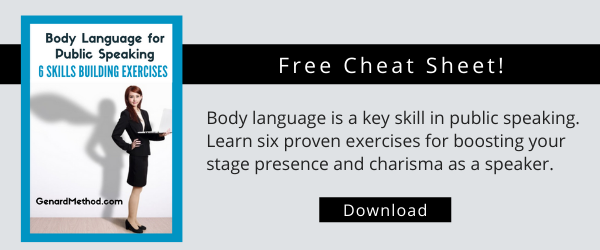If you fear public speaking, you already own one of the most effective tools for reducing your anxiety and building your confidence. And it's so close you literally can't see it.
It's your own body.
Body language is essential to understand and employ to help overcome speaking fear. That's true concerning both movement and gestures—what we traditionally think of as body language—and the "language of the body" in terms of our physiological response to stage fright.
Enlisting one's own body as a tool to eliminate speech anxiety is less understood than perhaps any strategy for coping with this problem. That's partly because so many of us are untrained in the performance aspects of public speaking.
Let's look more closely at this juncture of the body and the art of spoken performance.
The Body in Performance
Many people who suffer from fear of public speaking focus almost exclusively on overcoming negative thinking. Cognitive restructuring of this type is an essential element of eliminating speaking fear. As I discussed in my last blog, turning negative self-talk into positive thinking is helpful in establishing the right frame of mind for speaking in public.
The practice is not the be-all and the end-all of eliminating speaking fear, however. Two areas of equal importance are the physical aspects of performance, and the focus and mindfulness necessary to be fully present and connecting with listeners.
We have a body for a reason when it comes to spoken performance: to support and amplify what we're saying. Think about the times you discuss topics you're passionate about—do you stand stock still, without gestures or facial expressions? Of course not; your body gets into the act, animating and giving life and spirit to what you're saying, making your argument stronger and more convincing.
Now imagine trying to overcome speaking fear by only thinking about it without any awareness of body language, movement, or gestures. Clearly, that's impossible—yet anxious speakers do so all the time. If you're one of them, start thinking about your body as an essential tool of public speaking.
Always practice on your feet—and present that way whenever possible. Become friends with a large mirror or video camera or your smart phone, as you find ways to give physical expression to what you're saying. After all, your audiences respond strongly to visuals—and the strongest visual you have is yourself.
The Physiological Effects of Speech Anxiety
Along with body language, "the language that the body speaks" during speaking anxiety is another area you need to become familiar with. I'm speaking here of the physiological effects of stage fright: sweating, rapid and shallow breathing, pounding heart, shaky voice, and the rest of the cascade of responses that make you want to fight or flee this "dangerous" situation.
Again, seeking to eliminate speaking fear through a purely analytical process, without countering the physical aspects of speaking fear, is an impossible task. You can apply a rational process to your fear all you want, but it won't help you much when you're vomiting backstage.
So begin to understand and speak this "language of the body." As a start, learn diaphragmatic breathing—the foundation for developing presence of mind to stay calm and centered in the midst of speech anxiety. Use this 5-minute technique to calm your fear of public speaking. And practice muscle relaxation so you know what such a state feels like, and can apply it when you're getting tense and nervous before speaking.
Grounding Yourself and Using Space
Finally, discover how to use space effectively to become grounded and give yourself confidence. "Grounding" means standing with your feet at armpit- or shoulder-width to create a stable and steady platform from which to launch your ideas.
If this seems like a minor matter, try delivering a speech with your feet touching like a tin soldier, or with one leg crossed in front of the other, or leaning noticeably on one hip. You'll begin to understand why "how you stand affects your standing with your audience."
Once you've established a steady stance, you can move with purpose. And understand, you should move, not stand statue-still believing your content is powerful in itself (because of course it isn't—your material needs your body to enliven and strengthen it in delivery). Occupy a different spot for each main point. Move toward a questioner as you begin your answer. Approach the screen if you're displaying visual information. Move up and down the aisles, or around the boardroom table, to get close to every part of your audience.
The speaker who commands his or her performance space is one who both demonstrates and feels confidence. Let that be you.



